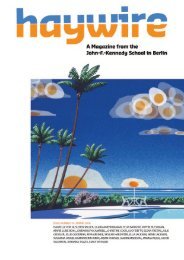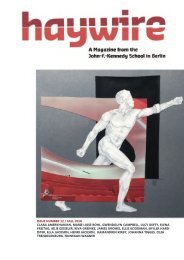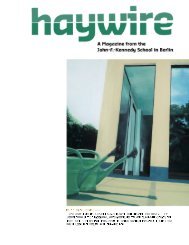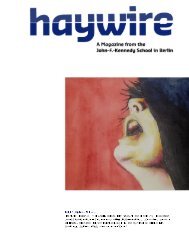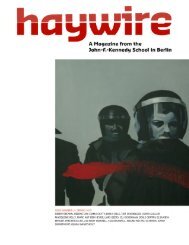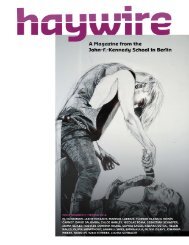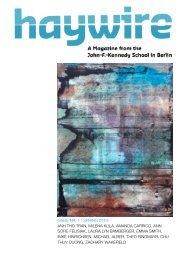Haywire Issue 4 Fall 2014
- No tags were found...
Create successful ePaper yourself
Turn your PDF publications into a flip-book with our unique Google optimized e-Paper software.
watch a captivating documentary<br />
about the history of the<br />
Hohenschönhausen prison and<br />
the people who were detained.<br />
The jail holds over two hundred<br />
cells and interrogation rooms<br />
that were used by the Stasi to<br />
question prisoners. Next, our<br />
tour guide led us into the basement.<br />
Bright lights illuminated<br />
the dirty, rough, white walls<br />
with peeling paint and the multiple<br />
pipes and cables running<br />
along the ceiling. A damp, metallic<br />
smell was very prominent.<br />
The only sound was that of our<br />
footsteps and of a heavy metal<br />
door to a cell further away<br />
banging shut.<br />
As we peered through the low<br />
door frame into the individual cells, I understood why they had been referred to as “submarines”. Positioned<br />
in the windowless room were only a wooden cot without a mattress and a bucket for human waste. I could<br />
vividly imagine that being in these cells must have felt similar to being in a submarine – confined in total<br />
darkness and isolation, with the sound of dripping water in the background. It was unbearable to think that,<br />
according to our tour guide, most of the prisoners that were held captive here had been<br />
The next thing we observed was a truck that had been used to deport suspicious civilians to this prison or<br />
other similar prisons, hidden in plain sight among other regular vehicles on the street due to their disguise as<br />
industrial cars. A feeling of claustrophobia and pure fear washed over me as I imagined how the prisoners in<br />
the tiny, built in cages in the trucks must have felt, with no idea where they were going or what would happen<br />
to them.<br />
Entering the prison building aboveground<br />
where the GDR prisoners<br />
had been kept, a smell of musty<br />
linoleum instantly filled the air. It<br />
struck me as ironic that there was a<br />
rose garden in the courtyard right<br />
outside of the barred windows to<br />
these cells; symbols of beauty and<br />
love right in the middle of such a<br />
horrid place. The prisoners could<br />
never see outside, however, as<br />
the windows were made of thick,<br />
glass blocks that only let in light.<br />
The hallways with the numbered<br />
doors to the cells (by which the<br />
prisoners were referred to instead<br />
of by their name) were lined with<br />
rough, faded wallpaper.<br />
HAYWIRE <strong>Issue</strong> 4 <strong>Fall</strong> <strong>2014</strong><br />
23







